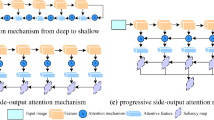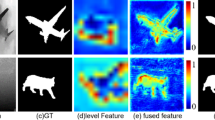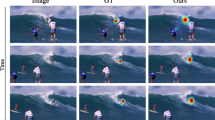Abstract
Existing saliency algorithms based on deep learning are not sufficient to extract features of images. And the features are fused only during decoding. As a result, the edge of saliency detection result is not clear and the internal structure display is not uniform. To solve the above problems, this paper proposes a saliency detection method of dual-stream encoding fusion based on RGB and grayscale image. Firstly, an interactive dual-stream encoder is constructed to extract the feature information of gray stream and RGB stream. Secondly, a multi-level fusion strategy is used to obtain more effective multi-scale features. These features are extended and optimized in the decoding stage by linear transformation with hybrid attention. Finally, We propose a hybrid weighted loss function. So that the prediction results of the model can keep a high level accuracy at pixel level and region level. The experimental results of the model proposed to this paper on 6 public datasets illustrate that: The prediction results of the proposed method are clearer about the edge of salient targets and more uniform within salient targets. And has a more lightweight model size.










Similar content being viewed by others
References
Achanta R, Hemami S, Estrada F, Susstrunk S (2009) Frequency-tuned salient region detection. In: 2009 IEEE conference on computer vision and pattern recognition. IEEE, pp 1597–1604
Boer P, Kroese DP, Mannor S, Rubinstein RY (2005) A tutorial on the cross-entropy method. Ann Oper Res 134(1):19–67
Borji A, Cheng M-M, Jiang H, Li J (2015) Salient object detection: a benchmark. IEEE Trans Image Process 24(12):5706–5722
Chen H, Li Y (2018) Progressively complementarity-aware fusion network for rgb-d salient object detection. In: Proceedings of the IEEE conference on computer vision and pattern recognition, pp 3051–3060
Cheng M-M, Mitra NJ, Huang X, Torr PH, Hu S-M (2014) Global contrast based salient region detection. IEEE Trans Pattern Anal Mach Intell 37 (3):569–582
Fan D-P, Lin Z, Zhang Z, Zhu M, Cheng M-M (2020) Rethinking rgb-d salient object detection: models, data sets, and large-scale benchmarks. IEEE Trans Neural Netw Learn Syst 32(5):2075–2089
Feng M, Lu H, Ding E (2019) Attentive feedback network for boundary-aware salient object detection. In: Proceedings of the IEEE/CVF conference on computer vision and pattern recognition, pp 1623–1632
Feng X, Zhou S, Zhu Z, Wang L, Hua G (2022) Local to global feature learning for salient object detection. Pattern Recogn Lett 162:81–88
Feng G, Meng J, Zhang L, Lu H (2022) Encoder deep interleaved network with multi-scale aggregation for rgb-d salient object detection. Pattern Recogn 128:108666
Gao Y, Shi M, Tao D, Xu C (2015) Database saliency for fast image retrieval. IEEE Trans Multimed 17(3):359–359
Goferman S, Zelnik-Manor L, Tal A (2012) Context-aware saliency detection. IEEE Trans Pattern Anal Mach Intell 34(10):1915–1926
Golner MA, Mikhael WB, Krishnang V (2002) Modified jpeg image compression with region-dependent quantization. Circ Syst Signal Process 21(2):163–180
Guo C, Zhang L (2010) A novel multiresolution spatiotemporal saliency detection model and its applications in image and video compression. IEEE Trans Image Process 19(1):185–198
Han K, Wang Y, Tian Q, Guo J, Xu C, Xu C (2020) Ghostnet: more features from cheap operations. In: Proceedings of the IEEE/CVF conference on computer vision and pattern recognition, pp 1580–1589
Hou Q, Cheng M-M, Hu X, Borji A, Tu Z, Torr PH (2017) Deeply supervised salient object detection with short connections. In: Proceedings of the IEEE conference on computer vision and pattern recognition, pp 3203–3212
Jerripothula KR, Cai J, Yuan J (2016) Image co-segmentation via saliency co-fusion. IEEE Press
Jiang H, Wang J, Yuan Z, Wu Y, Zheng N, Li S (2013) Salient object detection: a discriminative regional feature integration approach. IEEE conference on computer vision & pattern recognition
Lee G, Tai Y-W, Kim J (2016) Deep saliency with encoded low level distance map and high level features. In: Proceedings of the IEEE conference on computer vision and pattern recognition, pp 660–668
Li G, Yu Y (2015) Visual saliency based on multiscale deep features. In: Proceedings of the IEEE conference on computer vision and pattern recognition (CVPR), pp 5455–5463
Li Y, Hou X, Koch C, Rehg JM, Yuille AL (2014) The secrets of salient object segmentation. In: Proceedings of the IEEE conference on computer vision and pattern recognition, pp 280–287
Li G, Xie Y, Lin L, Yu Y (2017) Instance-level salient object segmentation. In: Proceedings of the IEEE conference on computer vision and pattern recognition, pp 2386–2395
Liu N, Han J (2016) Dhsnet: deep hierarchical saliency network for salient object detection. In: Proceedings of the IEEE conference on computer vision and pattern recognition, pp 678–686
Liu Z, Shi R, Shen L, Xue Y, Ngan KN, Zhang Z (2012) Unsupervised salient object segmentation based on kernel density estimation and two-phase graph cut. IEEE Trans Multimed 14(4):1275–1289
Liu J, Yuan M, Huang X, Su Y, Yang X (2022) Diponet: dual-information progressive optimization network for salient object detection. Digit Signal Process 126:103425
Lowe DG (2004) Distinctive image features from scale-invariant keypoints. Int J Comput Vis 60(2):91–110
Luo Z, Mishra A, Achkar A, Eichel J, Jodoin PM (2017) Non-local deep features for salient object detection. In: 2017 IEEE Conference on computer vision and pattern recognition (CVPR)
Mahadevan V, Vasconcelos N (2009) Saliency-based discriminant tracking. In: IEEE Conference on computer vision & pattern recognition
Movahedi V, Elder JH (2010) Design and perceptual validation of performance measures for salient object segmentation. In: 2010 IEEE computer society conference on computer vision and pattern recognition-workshops. IEEE, pp 49–56
Mu X, Qi H, Li X (2019) Automatic segmentation of images with superpixel similarity combined with deep learning. Circ Syst Signal Process 39(3)
Ojala T, Pietikäinen M, Harwood D (1996) A comparative study of texture measures with classification based on featured distributions. Pattern Recognit 29(1):51–59
Pang Y, Zhao X, Zhang L, Lu H (2020) Multi-scale interactive network for salient object detection. In: Proceedings of the IEEE/CVF conference on computer vision and pattern recognition, pp 9413–9422
Pinheiro PO, Lin T-Y, Collobert R, Dollár P (2016) Learning to refine object segments. In: European conference on computer vision. Springer, pp 75–91
Qin X, Zhang Z, Huang C, Gao C, Dehghan M, Jagersand M (2019) Basnet: boundary-aware salient object detection. In: Proceedings of the IEEE/CVf conference on computer vision and pattern recognition, pp 7479–7489
Qin X, Zhang Z, Huang C, Dehghan M, Zaiane OR, Jagersand M (2020) U2-net: going deeper with nested u-structure for salient object detection. Pattern Recogn 106:107404
Qu L, He S, Zhang J, Tian J, Tang Y, Yang Q (2017) Rgbd salient object detection via deep fusion. IEEE Trans Image Process 26 (5):2274–2285. https://doi.org/10.1109/TIP.2017.2682981
Ren Z, Gao S, Chia L, Tsang IW (2014) Region-based saliency detection and its application in object recognition. IEEE Trans Circ Syst Video Technol 24(5):769–779
Ren J, Wang Z, Ren J (2022) Ps-net: progressive selection network for salient object detection. Cognit Comput, pp 1–11
Ronneberger O, Fischer P, Brox T (2015) U-net: convolutional networks for biomedical image segmentation. In: International conference on medical image computing and computer-assisted intervention. Springer, pp 234–241
Rutishauser U, Walther D, Koch C, Perona P (2004) Is bottom-up attention useful for object recognition?. In: IEEE Computer society conference on computer vision & pattern recognition
Wang Z, Simoncelli EP, Bovik AC (2003) Multiscale structural similarity for image quality assessment. In: The thrity-seventh asilomar conference on signals, systems & computers, vol 2. IEEE, pp 1398–1402
Wang X, Han TX, Yan S (2009) An hog-lbp human detector with partial occlusion handling. In: 2009 IEEE 12th international conference on computer vision. IEEE, pp 32–39
Wang L, Lu H, Ruan X, Yang M -H (2015) Deep networks for saliency detection via local estimation and global search. In: Proceedings of the IEEE conference on computer vision and pattern recognition, pp 3183–3192
Wang L, Lu H, Wang Y, Feng M, Wang D, Yin B, Ruan X (2017) Learning to detect salient objects with image-level supervision. In: Proceedings of the IEEE conference on computer vision and pattern recognition, pp 136–145
Wang T, Zhang L, Wang S, Lu H, Yang G, Ruan X, Borji A (2018) Detect globally, refine locally: a novel approach to saliency detection. In: Proceedings of the IEEE conference on computer vision and pattern recognition, pp 3127–3135
Wang X, Zhu L, Tang S, Fu H, Li P, Wu F, Yang Y, Zhuang Y (2022) Boosting rgb-d saliency detection by leveraging unlabeled rgb images. IEEE Trans Image Process 31:1107–1119
Wu Z, Su L, Huang Q (2019) Cascaded partial decoder for fast and accurate salient object detection. In: Proceedings of the IEEE/CVF conference on computer vision and pattern recognition, pp 3907–3916
Wu R, Feng M, Guan W, Wang D, Lu H, Ding E (2020) A mutual learning method for salient object detection with intertwined multi-supervision. In: 2019 IEEE/CVF conference on computer vision and pattern recognition (CVPR)
Xu C, Li N, Zhang S, Wu Z (2014) Robust visual tracking with sift features and fragments based on particle swarm optimization. Circ Syst 33(5):1507–1526
Yan Q, Xu L, Shi J, Jia J (2013) Hierarchical saliency detection. In: Proceedings of the IEEE conference on computer vision and pattern recognition, pp 1155–1162
Yang C, Zhang L, Lu H, Ruan X, Yang M-H (2013) Saliency detection via graph-based manifold ranking. In: Proceedings of the IEEE conference on computer vision and pattern recognition, pp 3166–3173
Zhang YY, Wang ZP, Lv XD (2016) Saliency detection via sparse reconstruction errors of covariance descriptors on riemannian manifolds. Circ Syst Signal Process
Zhang J, Fan D-P, Dai Y, Anwar S, Saleh FS, Zhang T, Barnes N (2020) Uc-net: uncertainty inspired rgb-d saliency detection via conditional variational autoencoders. In: Proceedings of the IEEE/CVF conference on computer vision and pattern recognition, pp 8582–8591
Zhang J, Fan D-P, Dai Y, Yu X, Zhong Y, Barnes N, Shao L (2021) Rgb-d saliency detection via cascaded mutual information minimization. In: Proceedings of the IEEE/CVF international conference on computer vision, pp 4338–4347
Zhang H, Wu C, Zhang Z, Zhu Y, Lin H, Zhang Z, Sun Y, He T, Mueller J, Manmatha R (2022) Resnest: Split-attention networks. In: Proceedings of the IEEE/CVF conference on computer vision and pattern recognition, pp 2736–2746
Zhao R, Ouyang W, Li H, Wang X (2015) Saliency detection by multi-context deep learning. In: Proceedings of the IEEE conference on computer vision and pattern recognition, pp 1265–1274
Zhou H, Xie X, Lai J-H, Chen Z, Yang L (2020) Interactive two-stream decoder for accurate and fast saliency detection. In: Proceedings of the IEEE/CVF conference on computer vision and pattern recognition, pp 9141–9150
Zhu W, Liang S, Wei Y, Sun J (2014) Saliency optimization from robust background detection. In: Proceedings of the IEEE conference on computer vision and pattern recognition, pp 2814–2821
Acknowledgments
This work was supported by the Major Science and Technology Project in Henan Province [221100110500], Science and Technology Project of Henan Province [222102320380, 222102110194, 212102210161], the National Key Research and Development Project [2019YFB1311000].
Author information
Authors and Affiliations
Corresponding author
Ethics declarations
Conflict of interest
The authors declare no conflicts of interest regarding the publication of this paper. And The datasets generated and/or analyzed during the present study are available from the corresponding author on reasonable request.
Additional information
Publisher’s note
Springer Nature remains neutral with regard to jurisdictional claims in published maps and institutional affiliations.
Weishuo Zhao contributed equally to this work.
Rights and permissions
Springer Nature or its licensor (e.g. a society or other partner) holds exclusive rights to this article under a publishing agreement with the author(s) or other rightsholder(s); author self-archiving of the accepted manuscript version of this article is solely governed by the terms of such publishing agreement and applicable law.
About this article
Cite this article
Xu, T., Zhao, W., Chai, H. et al. Dual-stream encoded fusion saliency detection based on RGB and grayscale images. Multimed Tools Appl 82, 47327–47346 (2023). https://doi.org/10.1007/s11042-023-15217-z
Received:
Revised:
Accepted:
Published:
Issue Date:
DOI: https://doi.org/10.1007/s11042-023-15217-z




